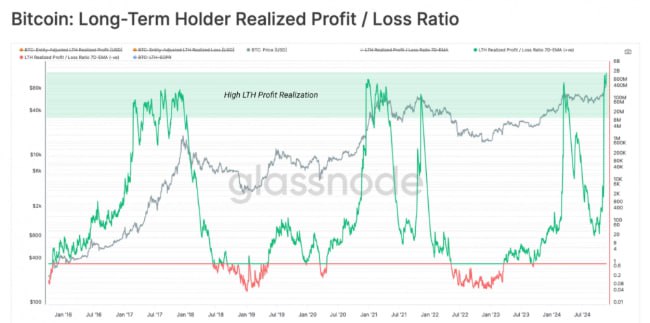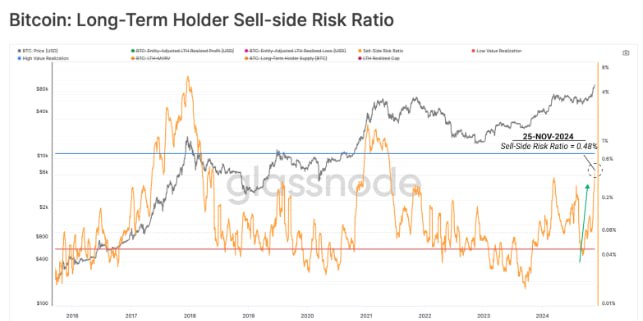Don't miss interesting news

Something is not quite normal on the Bitcoin market right now. On the one hand, the price has risen sharply, almost reaching a record high of $99,655. And this, of course, made many people start taking profits. In just one day, Bitcoin sales exceeded $2 billion!
These are really huge amounts, and the question immediately arises: hasn’t a massive sell-off begun?
But if you look more closely, the picture is not so clear. Most of these sales are made by new investors who have been holding their coins for only 6-12 months. They saw an opportunity to make money and started selling without hesitation. But the so-called “diamond hands” – investors who have been holding their assets for years – will not rush to sell and continue to wait.

The chart shows that in November, the ratio between profitable and unprofitable volumes held by long-term holders (LTH) increased sharply. This indicates a decrease in the number of coins at a loss due to a significant increase in prices.
From a historical point of view, such a phenomenon in the market is a sign of a period of emotional upswing, when prices remain at high levels for several months. However, in order for this trend to continue, a strong flow of new demand must be maintained at all times. If it weakens, the market may enter a phase of consolidation or correction.
Perhaps experienced owners are confident that this is only a temporary stop, and the real highs are still ahead.
This raises the question: who is now determining the market movement? Why are newcomers so eager to sell, while experienced investors are holding on to their assets, even against the backdrop of such record prices? Understanding this is the key to predicting the future of Bitcoin.
A wave of profitable sales began to sweep the market due to high demand and liquidity. As a result, a new record was set on November 22: market participants made $443 million in profit in one day.
At the same time, the market began to liquidate positions on a large scale, especially among those who played with leverage due to increased volatility. These liquidations further exacerbated short-term price fluctuations, a typical pattern when the market is approaching new all-time highs.
All of this shows that demand for BTC remains high, but for the market to continue growing, more new liquidity is needed to absorb the amount of realized profit and maintain the positive trend.
The chart shows that the Sell-Side Risk Ratio is currently at high levels, indicating that long-term investors are realizing significant profit at this stage, although they remain calm. This indicator reflects the total amount of both gains and losses that investors have recorded compared to the size of assets (via Realized Cap).
High values of this ratio indicate that investors are actively selling their assets at a substantial gain or loss from their initial investments, which usually occurs during times of high volatility, and this requires a new rebalancing in the market.
It can also be seen that the Sell-Side Risk Ratio is approaching the upper limit, which confirms that active profit realization is currently taking place. However, the current value of this indicator is still significantly lower than during previous bull market cycles. This means that, despite the current selling process, the market has not yet reached the level where there is a complete reallocation of assets, as was the case in previous cycles.

The next graph will clearly show what we have already mentioned – coins bought in the last 6-12 months are involved in current sales and profit realization the most. They account for 35.3% of the total amount of realized profit, which emphasizes the impact of new market participants on the situation.
Most of this volume is likely due to the so-called “swing trade” strategy, where investors buy assets at low prices and then sell when the price rises, locking in profits for short periods of time.

If we talk in numbers, then:
The main idea is to help you better understand how the market is changing and how different groups of investors behave. If you’ve just started trading, you should consider the risks of short-term fluctuations and not panic when selling at peaks. But experienced investors need to remain vigilant, follow trends, and keep a long-term strategy in mind, because what is happening now may only be a temporary stage before the next growth.